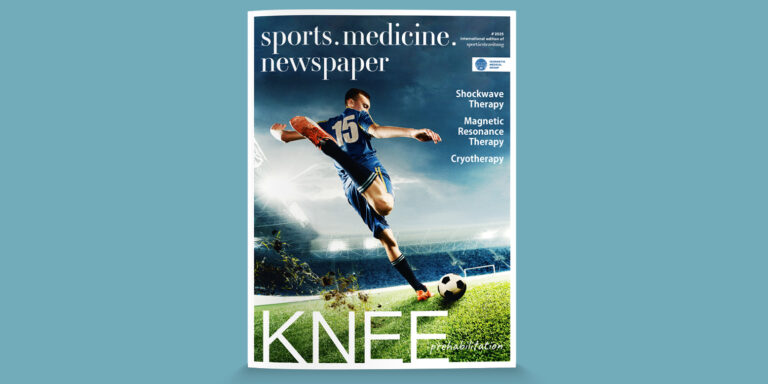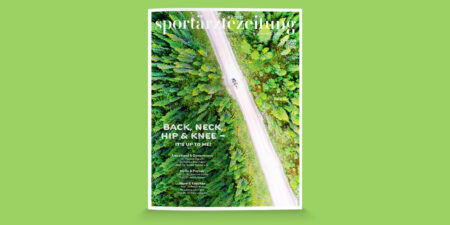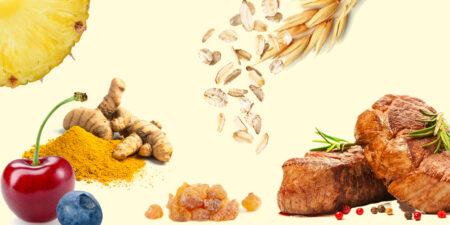Targeted nutrition in musculoskeletal pre- and rehabilitation has become increasingly important in recent years. In their current article ‘Prehabilitation Of The Anterior Cruciate Ligament’ (see pages 2 – 6), Valle / Marshall / Mengis emphasise that a patient’s nutritional status before and after surgery has a decisive influence on the healing outcome of musculoskeletal diseases.
According to the authors, a protein- and carbohydrate-rich diet is recommended 7 – 10 days before surgery to promote wound healing, graft healing and maintenance of muscle mass [1, 2]. Furthermore, they address the increased calorie requirement and the minimum daily intake of amino acids [3] as well as the importance of micronutrients for wound healing [2, 4 – 5] and point out the lack of large randomised controlled trials (RCTs) to date that clearly demonstrate the effectiveness of these nutritional interventions [6].
Integration of nutraceuticals in musculoskeletal rehabilitation
The latest research results on the rehabilitation of anterior cruciate ligament injuries (ACL) show that certain bioactive substances in food can promote the healing process through anti-inflammatory effects, support tissue regeneration and improve joint health. A recent review highlights the following active ingredients in particular [7]:
Curcumin
Curcumin works by inhibiting post-traumatic inflammatory processes, activating stem cells and regulating collagen metabolism [8 – 10]. An interesting approach is the combination with nanotechnology as curcumin nanoparticles, which, for example, could improve the bioavailability in the tissue and thus achieve a higher effect, but this form of application is not yet widely used and investigated [7]. In the case of acute injuries or operations, however, the optimal timing of therapy must be discussed on the basis of the physiological inflammatory response. For further information, see [11].
Omega-3 fatty acids
Omega-3 fatty acids, in particular eicosapentaenoic acid (EPA) and docosahexaenoic acid (DHA), help to reduce inflammatory processes and promote tissue regeneration by reducing pro-inflammatory cytokines and inducing anti-inflammatory molecules (known as resolvins) [12]. In addition, omega-3 fatty acids influence gene expression by affecting inflammatory transcription factors [13]. Clinical studies have already shown positive effects on muscular regeneration [14]; however, the optimal timing of therapy is controversial due to the physiological inflammatory response in the first few days after injury.
Bromelain
Bromelain is a proteolytic enzyme found in pineapples that has anti-inflammatory and decongestant properties. It also has immunomodulatory effects via the activation of macrophages, lymphocytes and natural killer cells [15]. Although the use of bromelain is relatively widespread in the context of injuries or surgery and has been relatively well researched in dentistry in particular [16], clinical data on its effects in the pre- and rehabilitation phases are lacking in the musculoskeletal field.
Vitamin D
Low serum levels of 25-hydroxy-vitamin D are associated with an increased incidence of injuries (e.g. muscle injuries and stress fractures; [17, 18]), increased levels of pro-inflammatory cytokines [19] and biomarkers, as well as increased postoperative loss of strength [20]. Since vitamin D metabolism is extremely complex and many of the active processes only take place in the body over the longer term, the use of vitamin D derivatives is less important in the phase of acute injury and more so as a long-term supplement.
Vitamin C and antioxidants
Reactive oxygen species (ROS) are formed during metabolism and play a dual role: on the one hand, they can promote muscle breakdown, but on the other hand, they are essential for training adaptations. Antioxidants such as vitamin C or polyphenols neutralise excess ROS, but an excess of antioxidants can impair recovery because positive ROS-mediated adaptation processes would be inhibited [21, 22]. Instead of long-term supplementation with isolated antioxidant preparations (e. g. high-dose vitamin C), a balanced diet with antioxidant-rich foods such as fruit and vegetables is recommended as a preventive measure to optimally support regeneration after injuries [23]. In the case of highly acute inflammation, however, antioxidant preparations can be considered to slow down the excessive inflammatory response.
Conclusion
The integration of nutraceuticals into musculoskeletal rehabilitation represents a forward-looking strategy. While preclinical and initial clinical studies are promising, further large-scale randomised studies are needed to validate the optimal dosage and long-term effects. Interdisciplinary collaboration between orthopaedists, nutritionists and sports scientists is crucial to integrate individual nutrition concepts into multimodal rehabilitation.
Bibliography
- Hirsch, K.R., R.R. Wolfe, and A.A. Ferrando,Pre- and Post-Surgical Nutrition for Preservation of Muscle Mass, Strength, and Functionality Following Orthopedic Surgery.Nutrients, 2021. 13(5).
- Smith-Ryan, A.E., et al.,Nutritional Considerations and Strategies to Facilitate Injury Recovery and Rehabilitation. J Athl Train, 2020. 55(9): p. 918-930.
- Papadopoulou, S.K.,Rehabilitation Nutrition for Injury Recovery of Athletes: The Role of Macronutrient Intake. Nutrients, 2020. 12(8).
- Shaw, G., B. Serpell, and K. Baar,Rehabilitation and nutrition protocols for optimising return to play from traditional ACL reconstruction in elite rugby union players: A case study. J Sports Sci, 2019. 37(15): p. 1794-1803.
- Owens, D.J., et al.,Exercise-induced muscle damage: What is it, what causes it and what are the nutritional solutions? Eur J Sport Sci, 2019. 19(1): p. 71-85.
- Greif, D.N., et al.,Supplement Use in Patients Undergoing Anterior Cruciate Ligament Reconstruction: A Systematic Review.Arthroscopy, 2020. 36(9): p. 2537-2549.
- Haojie, D., Bhattacharya, T., Mukherjee, S. (2024). Review perspective on advanced nutraceuticals and anterior cruciate ligament rehabilitation. Naturforsch. 2024; aop. https://doi.org/10.1515/znc-2024-0169
- Zhang W, Li X, Comes Franchini M, Xu K, Locatelli E, Martin RC, Monaco I, Li Y, Cui S: Controlled release of curcumin from curcumin-loaded nanomicelles to prevent peritendinous adhesion during Achilles tendon healing in rats. Int J Nanomedicine 2016, 11:2873-2881.
- Güleç A, Türk Y, Aydin BK, Erkoçak Ö F, Safalı S, Ugurluoglu C: Effect of curcumin on tendon healing: an experimental study in a rat model of Achilles tendon injury. Int Orthop 2018, 42:1905-1910.
- Chen Y, Xie Y, Liu M, Hu J, Tang C, Huang J, Qin T, Chen X, Chen W, Shen W, Yin Z: Controlled-release curcumin attenuates progression of tendon ectopic calcification by regulating the differentiation of tendon stem/progenitor cells. Mater Sci Eng C Mater Biol Appl 2019, 103:109711.
- Shakibae, M., et al., Phytopharmaka und Extrakorporale Stoßwellen bei Tendinopathien. sportärztezeitung 03/22 https://sportaerztezeitung.com/rubriken/therapie/12118/phytopharmaka-und-extrakorporale-stosswellen-bei-tendinopathien/
- Giraldo-Vallejo, J. E., Cardona-Guzmán, M. Á., Rodríguez-Alcivar, E. J., Kočí, J., Petro, J. L., Kreider, R. B., Cannataro, R., & Bonilla, D. A. (2023). Nutritional Strategies in the Rehabilitation of Musculoskeletal Injuries in Athletes: A Systematic Integrative Review. Nutrients, 15(4), 819. https://doi-org.eaccess.tum.edu/10.3390/nu15040819
- Close G.L., Sale C., Baar K., Bermon S. Nutrition for the Prevention and Treatment of Injuries in Track and Field Athletes. J. Sport Nutr. Exerc. Metab. 2019;29:189–197. doi: 10.1123/ijsnem.2018-0290.
- Tachtsis B., Camera D., Lacham-Kaplan O. Potential roles of n-3 PUFAs during skeletal muscle growth and regeneration. 2018;10:309. doi: 10.3390/nu10030309.
- Kansakar, U., Trimarco, V., Manzi, M. V., Cervi, E., Mone, P., & Santulli, G. (2024). Exploring the Therapeutic Potential of Bromelain: Applications, Benefits, and Mechanisms. Nutrients, 16(13), 2060. https://doi-org.eaccess.tum.edu/10.3390/nu16132060
- Mendes, M. L., do Nascimento-Júnior, E. M., Reinheimer, D. M., & Martins-Filho, P. R. (2019). Efficacy of proteolytic enzyme bromelain on health outcomes after third molar surgery. Systematic review and meta-analysis of randomized clinical trials. Medicina oral, patologia oral y cirugia bucal, 24(1), e61–e69. https://doi-org.eaccess.tum.edu/10.4317/medoral.22731
- Rebolledo B.J., Bernard J.A., Werner B.C., Finlay A.K., Nwachukwu B.U., Dare D.M., Warren R.F., Rodeo S.A., Surgery R. The association of vitamin D status in lower extremity muscle strains and core muscle injuries at the National Football League Combine. Arthrosc. Relat. Surg. 2018;34:1280–1285. doi: 10.1016/j.arthro.2017.10.005.
- Ruohola J.P., Laaksi I., Ylikomi T., Haataja R., Mattila V.M., Sahi T., Tuohimaa P., Pihlajamaki H. Association between serum 25(OH)D concentrations and bone stress fractures in Finnish young men. Bone Miner. Res. Off. J. Am. Soc. Bone Miner. Res. 2006;21:1483–1488. doi: 10.1359/jbmr.060607.
- Pilch W., Kita B., Piotrowska A., Tota Ł., Maciejczyk M., Czerwińska-Ledwig O., Sadowska-Krepa E., Kita S., Pałka T. The effect of vitamin D supplementation on the muscle damage after eccentric exercise in young men: A randomized, control trial. Int. Soc. Sports Nutr. 2020;17:1–10. doi: 10.1186/s12970-020-00386-1.
- Barker T., Schneider E.D., Dixon B.M., Henriksen V.T., Weaver L.K. Supplemental vitamin D enhances the recovery in peak isometric force shortly after intense exercise. Metab. 2013;10:69. doi: 10.1186/1743-7075-10-69
- Powers S.K., Smuder A.J., Judge A.R. Oxidative stress and disuse muscle atrophy: Cause or consequence? Opin. Clin. Nutr. Metab. Care. 2012;15:240–245. doi: 10.1097/MCO.0b013e328352b4c2.
- Niess A.M., Simon P. Response and adaptation of skeletal muscle to exercise–the role of reactive oxygen species. Biosci.: J. Virtual Libr. 2007;12:4826–4838. doi: 10.2741/2431.
- Close G.L., Jackson M.J. Antioxidants and exercise: A tale of the complexities of relating signalling processes to physiological function? Physiol. 2014;592:1721–1722. doi: 10.1113/jphysiol.2014.272294.
Autoren
ist Assistenzarzt Sektion Sportorthopädie, TUM Universitätsklinikum Rechts der Isar, München. Er hat am Lehrstuhl Anatomie II der LMU über die regenerative Stammzelltherapie bei Sehnendefekten promoviert. Seine Forschungsschwerpunkte sind die Extrakorporale Stoßwellentherapie (ESWT) und physikalische Verfahren in der Orthopädie. Zuvor war er in der sportmedizinischen Praxis MedWorks Augsburg tätig.




